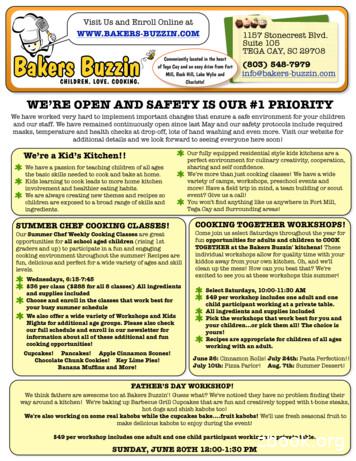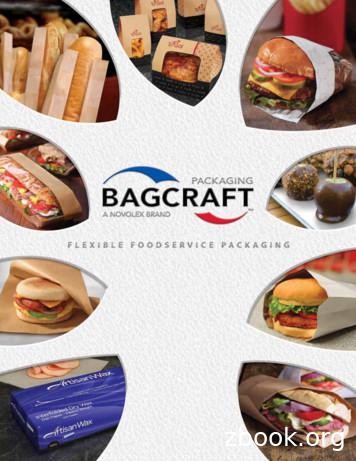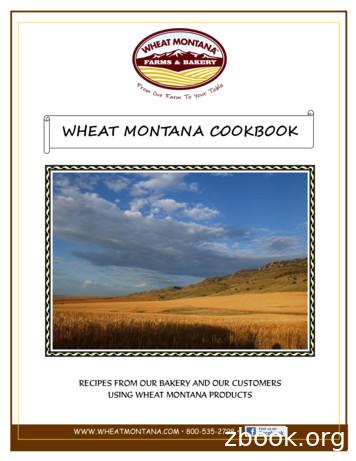Grades 9 To 12 Baking And Pastry Arts - Province Of Manitoba
Grades 9 to 12Baking andPastry ArtsManitoba Technical-VocationalCurriculum Frameworkof Outcomes
Gr ades 9 to 12Bak ing and Pa s try Art sManitoba Technical-Vocational CurriculumFramework of Outcomes2014Manitoba Education and Advanced Learning
Manitoba Education and Advanced Learning Cataloguing in Publication DataGrades 9 to 12 baking and pastry arts [electronic resource] : Manitobatechnical-vocational curriculum framework of outcomesIncludes bibliographical references.ISBN: 978-0-7711-5688-51. Baking and pastry arts—Study and teaching (Secondary)—Manitoba.2. Industrial arts—Study and teaching (Secondary)—Manitoba.3. Technical education—Manitoba—Curricula.4. Vocational education—Manitoba—Curricula.I. Manitoba. Manitoba Education and Advanced Learning.694.0712Copyright 2014, the Government of Manitoba, represented by the Minister ofEducation and Advanced Learning.Manitoba Education and Advanced LearningSchool Programs DivisionWinnipeg, Manitoba, CanadaEvery effort has been made to acknowledge original sources and to complywith copyright law. If cases are identified where this has not been done, pleasenotify Manitoba Education and Advanced Learning. Errors or omissions will becorrected in a future edition.Any websites referenced in this document are subject to change. Educatorsare advised to preview and evaluate websites and online resources beforerecommending them for student use.This resource is available on the Manitoba Education and AdvancedLearning website at www.edu.gov.mb.ca/k12/cur/teched/sy tech program.html .Available in alternate formats upon request.
ContentsAcknowledgementsTechnical-Vocational Education OverviewBaking and Pastry Arts Overviewv11Introduction1Correlation with Level 1 of Red Seal Baker2Goals and General Learning Outcomes (GLOs)3Specific Learning Outcomes (SLOs)4Guide to Reading Baking and Pastry ArtsGoals and Learning Outcomes5Course Descriptions6Grades 9 to 11 Baking and Pastry Arts General andSpecific Learning Outcomes by Goal9Goal 1: Describe and apply appropriate sanitation,health, and safety practices as they apply to thebaking and pastry arts.11Goal 2: Demonstrate the safe and appropriateoperation, cleaning, maintenance, and storageof baking equipment and utensils.19Goal 3: Demonstrate an understanding of bakeryingredients, components, recipes/formulations, andproducts, as well as their nutritional qualities.27Goal 4: Demonstrate the appropriate receiving,handling, quality assurance, packaging, storage,and inventory control of baking ingredients andbaked products.33Goal 5: Demonstrate the appropriate preparation(mise en place), mixing, make-up, baking, finishing(or decoration), and presentation of bakingingredients and products.34Goal 6: Demonstrate an understanding of careeropportunities in baking.51528231 Exploration of Baking and Pastry Arts68324 Introduction to Baking and Pastry Arts68338 Quick Breads, Cookies, Doughnuts, and Pies68339 Yeast-Dough Products68358 Cakes, Fillings, Icings, and Decorations68359 Tarts and Special Pastries6Goal 7: Describe and demonstrate the transferable,cross-curricular knowledge and skills as theypertain to baking.8374 Modern and Classic Desserts, andPlating Techniques7Goal 8: Demonstrate awareness of sustainabilityas it pertains to the baking industry.558375 Advanced Bread Products78998 Advanced Baking and Pastries7Goal 9: Demonstrate awareness of the ethical andlegal standards as they pertain to baking.58Goal 10: Demonstrate the employability skills relatedto the baking industry.60Curriculum Implementation Dates7Contentsiii
Goal 11: Demonstrate an understanding of theevolution and technological progression of, andthe emerging trends in baking.Grade 12 Baking and Pastry Arts General andSpecific Learning Outcomes by Goaliv6392Goal 11: Demonstrate an understanding of theevolution and technological progression of, andthe emerging trends in baking.9465Goal 1: Describe and apply appropriate sanitation,health, and safety practices as they apply to thebaking and pastry arts.67Goal 2: Demonstrate the safe and appropriateoperation, cleaning, maintenance, and storageof baking equipment and utensils.74Goal 3: Demonstrate an understanding of bakeryingredients, components, recipes/formulations, andproducts, as well as their nutritional qualities.75Goal 4: Demonstrate the appropriate receiving,handling, quality assurance, packaging, storage,and inventory control of baking ingredients andbaked products.81Goal 5: Demonstrate the appropriate preparation(mise en place), mixing, make-up, baking, finishing(or decoration), and presentation of bakingingredients and products.82Goal 6: Demonstrate an understanding of careeropportunities in baking.87Goal 7: Describe and demonstrate the transferable,cross-curricular knowledge and skills as theypertain to baking.88Goal 8: Demonstrate awareness of sustainabilityas it pertains to the baking industry.90Goal 9: Demonstrate awareness of the ethical andlegal standards as they pertain to baking.91Grades 9 to 12 Baking and Pastry ArtsGoal 10: Demonstrate the employability skills relatedto the baking industry.Bibliography95
AcknowledgementsManitoba Education and Advanced Learning gratefully acknowledges the contributions of the following individuals in thedevelopment of Grades 9 to 12 Baking and Pastry Arts: Manitoba Technical-Vocational Curriculum Framework of Outcomes.Development Team MembersMary-Jane FeekeIndependent ConsultantSelkirk, ManitobaAinsley LaFlècheKildonan East CollegiateRiver East Transcona School DivisionAndy OrmistonLord Selkirk Regional Secondary SchoolLord Selkirk School DivisionHans SchweitzerIndependent ConsultantWinnipeg, ManitobaTerry WillertonTechnical Vocational High SchoolWinnipeg School DivisionAcknowledgementsv
School Programs Division,Manitoba Education and AdvancedLearning StaffviCarole BilykProject ManagerDevelopment UnitInstruction, Curriculum and Assessment BranchLouise BoissonneaultCoordinatorDocument Production Services UnitEducational Resources BranchDiane CourcellesPublications EditorDocument Production Services UnitEducational Resources BranchJohn FinchActing Coordinator(from September 2013)Technical Vocational Education UnitInstruction, Curriculum and Assessment BranchLynn HarrisonDesktop PublisherDocument Production Services UnitEducational Resources BranchGilles LandryProject LeaderDevelopment UnitInstruction, Curriculum and Assessment BranchDaniel LemieuxConsultantTechnical Vocational Education UnitInstruction, Curriculum and Assessment BranchPeter NarthCoordinator(until September 2013)Technical Vocational Education UnitInstruction, Curriculum and Assessment BranchKen NimchukConsultantTechnical Vocational Education UnitInstruction, Curriculum and Assessment BranchGrades 9 to 12 Baking and Pastry Arts
Te c h n i c a l- V o c a t i o n a lEduc at ion Overv iewIn 2013, Manitoba Education released the documentTechnical-Vocational Education Overview to provide thephilosophical and pedagogical underpinnings for curriculumdevelopment and the teaching of courses in the Senior YearsTechnology Education Program. This overview presentseducators with the vision and goals of technical-vocationaleducation (TVE) in Manitoba.Topics include the following:QQcurriculum revitalization and renewalQQcurriculum framework and implementationQQarticulation of programmingQQassessment and reportingQQsafetyQQemployability/essential skills and career developmentQQsustainable developmentThe TVE curriculum includes Grades 9 to 12 courses in avariety of areas, including baking and pastry arts.Bak ing and Pa s try ArtsOverviewIntroductionGrades 9 to 12 Baking and Pastry Arts: Manitoba TechnicalVocational Curriculum Framework of Outcomes identifiesthe goals, general learning outcomes (GLOs), and specificlearning outcomes (SLOs) for nine baking and pastry artscourses. This framework is intended for use in all Manitobaschools teaching baking and pastry arts courses as part of theSenior Years Technology Education Program.All courses are intended for students pursuing a career inthe baking and pastry industry. They focus on theoreticalprinciples and their practical applications. Most coursesinclude outcomes related toQQQQQQQQQQsanitation, health, and safety practices as they apply tobaking and the pastry artsthe operation, cleaning, maintenance, and storage ofbaking equipment and utensilsan understanding of bakery ingredients, components,recipes/formulas, and products, as well as theirnutritional qualitiesthe receiving, handling, quality assurance, packaging,storage, and inventory control of baking ingredients andbaked productsthe preparation (mise en place), mixing, make-up,baking, finishing (or decoration) and presentation ofbaking ingredients and productsOverview1
QQQQQQknowledge of career opportunities in bakingtransferable, cross-curricular knowledge and skills asthey pertain to bakingawareness of sustainability as it pertains to the bakingindustryQQthe ethical and legal standards as they pertain to bakingQQfundamental employability skillsQQan understanding of the evolution and technologicalprogression of, and the emerging trends in bakingTo receive a Senior Years Technical Education diploma, astudent must complete eight departmentally developedcourses from an approved technical-vocational cluster,together with 16 compulsory credits and six optional credits.The grade level in which the courses are offered are a local,school-based decision, but it is highly recommended that thesequencing of credits align with the following schedule.In the TVE curriculum, the emphasis is on applied activities.For instructional purposes, the sequence of learningoutcomes can vary based on the activities within the course.Teachers are advised to select the activities best suited toteach the outcomes, based on a variety of factors, includingaccess to resources, or regional needs.QQ2The curriculum is not sequential. In other words,outcomes might be taught in an order that differs fromthe one in this document.Grades 9 to 12 Baking and Pastry ArtsQQIn light of rapidly changing trends in baking and pastryarts, teachers are encouraged to update their activities inorder to meet the needs of students.A student graduating from the Baking and PastryArts program can seek employment as an entry levelbaker or patissier in a variety of occupations includingcake decorating, commercial baking, artisan baking,confectionery, chocolatier, and so forth. Related careersinclude, but are not limited to areas such as food science andresearch, nutritionist, dietician, hospitality management,bakery owner, baking teacher, and food stylist.To help further their careers in Baking and Pastry Arts,graduates have the option of seeking post-secondarytraining. Apprenticeship opportunities are available in mostjurisdictions outside of Manitoba.Baking and Pastry Arts graduates are typically employedin a variety of locations including bakeries, hotels andconvention centres, cafeterias, health care facilities, foodproduction and research facilities, and so on.Correlation with Level 1 of Red Seal BakerThe Specific Learning Outcomes in the 8 mandatory coursesare based on objectives found in Level 1 of the Red SealCurriculum for Baker. The most recent version of the RedSeal document can be viewed at www.red-seal.ca .
Goals and General Learning Outcomes (GLOs)The Baking and Pastry Arts curriculum includes 11 goals,which are broken down into general learning outcomes,which are further broken down into specific learningoutcomes.Goal 1: Describe and apply appropriate sanitation, health,and safety practices as they apply to the bakingand pastry arts.GLO 1.1: Demonstrate appropriate personal sanitationand hygiene practices.GLO 1.2: Demonstrate safe food-handling practices.GLO 1.3: Create and maintain a safe workenvironment.Goal 2: Demonstrate the safe and appropriate operation,cleaning, maintenance, and storage of bakingequipment and utensils.GLO 2.1: Demonstrate the safe and appropriateoperation of baking equipment andutensils.GLO 2.2: Demonstrate the safe and appropriatecleaning, maintenance, and storage ofbaking equipment and utensils.Goal 3: Demonstrate an understanding of bakeryingredients, components, recipes/formulations, and products, as well as theirnutritional qualities.GLO 3.1: Demonstrate an understanding of bakeryingredients, and how their characteristicsare used to design formulations and preparebakery products.GLO 3.2: Demonstrate an understanding of recipes/formulations used in baking.GLO 3.3: Demonstrate an understanding of thecharacteristics of bakery components andproducts.GLO 3.4: Demonstrate an understanding of nutrition.Goal 4: Demonstrate the appropriate receiving, handling,quality assurance, packaging, storage, andinventory control of baking ingredients and bakedproducts.GLO 4.1: Demonstrate the appropriate receiving,handling, quality assurance, packaging,storage, and inventory control of bakingingredients and baked products.Goal 5: Demonstrate the appropriate preparation (miseen place), mixing, make-up, baking, finishing(or decoration), and presentation of bakingingredients and products.GLO 5.1: Demonstrate the appropriate preparation(mise en place), mixing, and make-up ofbaking ingredients and products.GLO 5.2: Demonstrate the appropriate baking of variousproducts.GLO 5.3: Demonstrate the appropriate assembly,finishing, and decoration of baked products.GLO 5.4: Demonstrate the appropriate presentation ofbaked products.Goal 6: Demonstrate an understanding of careeropportunities in baking.GLO 6.1: Describe apprenticeship, education,and career opportunities, as well asprofessional organizations in the bakingindustry.Goal 7: Describe and demonstrate the transferable, crosscurricular knowledge and skills as they pertain tobaking.GLO 7.1: Read, interpret, and communicateinformation relevant to baking.Overview3
GLO 7.2: Apply mathematics knowledge and skillsrelevant to baking.GLO 7.3: Apply science knowledge and skills relevant tobaking.GLO 7.4: Apply other subject areas (French, physicaleducation/health education, informationcommunication, and technology) knowledge andskills relevant to baking.Goal 8: Demonstrate awareness of sustainability as itpertains to the baking industry.GLO 8.1: Describe the impact of human sustainabilityon the health and well-being of bakers andconsumers of baked products.GLO 8.2: Describe the baking industry’s sustainabilitypractices and impact on the environment.GLO 8.3: Describe sustainable economic practiceswithin the baking industry.Goal 9: Demonstrate awareness of the ethical and legalstandards as they pertain to baking.GLO 9.1: Apply the ethical and legal standards as theypertain to baking.Goal 10: Demonstrate the employability skills related tothe baking industry.GLO 10.1: Demonstrate fundamental employabilityskills.GLO 10.2: Demonstrate an understanding of the businessoperation of a bakeshop.Goal 11: Demonstrate an understanding of the evolutionand technological progression of, and theemerging trends in baking.GLO 11.1: Demonstrate an understanding of theevolution and technological progressionof, and the emerging trends in baking.4Grades 9 to 12 Baking and Pastry ArtsSpecific Learning Outcomes (SLOs)Grades 9 to 12 Baking and Pastry Arts: Manitoba TechnicalVocational Curriculum Framework of Outcomes identifiesspecific learning outcomes (SLOs) for use in all Manitobaschools teaching the Grades 9 to 12 baking and pastry artscourses as part of the Senior Years Technology EducationProgram. Specific learning outcome statements define whatstudents are expected to achieve by the end of the course.It is essential for students to learn and to demonstrate safetypractices and employability skills; therefore, some SLOsrelated to safety and to employability skills are repeated inall the courses.
Guide to Reading the Baking and Pastry Arts Goals and Learning OutcomesCourse code8231Exploration ofBaking andPastry Arts (9)15S / 15E / 15M10S / 10E / 10MGeneral learningoutcome (GLO):First digit indicatesgoal number;second digitindicates individualGLO8324Introduction toBaking andPastry Arts (10)20S / 20E / 20MCourse name8338Quick Breads,Cookies,Doughnuts, andPies (11A)30S / 30E / 30M8339Yeast-DoughProducts (11B)30S / 30E / 30M8358Cakes, Fillings,Icings, andDecorations (11C)30S / 30E / 30MGoal 2: Demonstrate the safe and appropriate operation, cleaning, maintenance, and storage of bakingequipment and utensils.Grade/levelGoal statementGLO 2.1: Demonstrate the safe and appropriate operation of baking equipment and utensils.9.2.1.1 Demonstrate thesafe and appropriateoperation and/or useof tools and equipmentassociated withpatisserie and baking.10.2.1.111A.2.1.1 Demonstratethe safe andappropriate operationand/or use of tools andequipment associatedwith the production ofquick breads, cookies,doughnuts, and pies.11B.2.1.1 Demonstrateknowledge of the typesof pans and trays suchas four-strap, sheet,Pullman, and basket.11C.2.1.1 Demonstratethe safe andappropriate operationand/or use of tools andequipment associatedwith cake decorating.9.2.1.2 Demonstratethe ability to selectnon-mechanizedequipment for a 2.1.3 Demonstrateknowledge of thetypes of se.Goal.GLO.SLOIndicates SLOsfrom previouscourse are repeatedin this course11C.2.1.3Specific learningoutcome (SLO)statements definewhat students areexpected to achieveby the end of thecourse.Grades 9 to 11 Baking and Pastry Arts19Overview5
Course DescriptionsCourse titles, descriptions, and codes for the nine baking andpastry arts courses follow. For an explanation of the codes,refer to the Subject Table Handbook: Technology Education:Student Records System and Professional School Personnel System(Manitoba Education and Advanced Learning).8231 Exploration of Baking and Pastry Arts15S/15E/15M10S/10E/10MThis is an optional course intended for students wishingto explore the baking and pastry arts. The emphasis is onintroductory, hands-on activities.8324 Introduction to Baking and Pastry Arts20S/20E/20MThis course is intended to introduce students to a potentialcareer in baking and pastry arts. The emphasis is onhands-on activities, covering a wide spectrum of baking;including cookies, cakes, quick breads, yeast-doughproducts, pies, and pastries.6Grades 9 to 12 Baking and Pastry Arts8338 Quick Breads, Cookies, Doughnuts, and Pies30S/30E/30MThis course is intended for students who are consideringa career in baking and pastry arts. The emphasis is on thepreparation of quick breads, cookies, doughnuts, and pies.8339 Yeast-Dough Products30S/30E/30MThis course is intended for students who are consideringa career in baking and pastry arts. The emphasis is on thepreparation of yeast-dough products such as breads, rolls,cinnamon buns, and pretzels.8358 Cakes, Fillings, Icings, and Decorations30S/30E/30MThis course is intended for students who are consideringa career in baking and pastry arts. The emphasis is on thepreparation of cakes, pastry cream, mousse, icings, anddecorations.8359 Tarts and Special Pastries40S/40E/40MThis course is intended for students who are intending topursue a career in baking and pastry arts. The emphasis ison French, international, modern, elegant, and fancy pastriesand desserts.
8374 Modern and Classic Desserts, andPlating Techniques40S/40E/40MThis course is intended for students who are intending topursue a career in baking and pastry arts. The emphasis is onmodern and classic desserts (including frozen desserts) andplating techniques.8375 Advanced Bread Products40S/40E/40MThis course is intended for students who are intending topursue a career in baking and pastry arts. The emphasisis on artisan bread, rolls, crackers, unleavened bread, andbannock.8998 Advanced Baking and Pastries40S/40E/40MThis course is intended for students who are intending topursue a career in baking and pastry arts. The emphasis ison specialty cakes, as well as chocolate,
The TVE curriculum includes Grades 9 to 12 courses in a variety of areas, including baking and pastry arts. Ba k i n G a n d Pa s t r y ar t s oV e r V i e w Introduction Grades 9 to 12 Baking and Pastry Arts: Manitoba Technical-Vocational Curriculum Framework of Outcomes identifies the goals, general learning outcomes (GLOs), and specific
fathers day workshop 12:00-1:30 21 summer camps baking bonanza! 22 summer camps baking bonanza! 23 summer camps baking bonanza! 6:15-7:45 summer chef classes! 24 summer camps baking bonanza! 25 summer camps baking bonanza! 26 10:00-11:30 cooking together saturdays! cinnamon rolls! 6:00-8:
Describe and use the equipment typical to the baking process Describe and demonstrate the basic baking science principles, ratio and technique Required Text, Materials and Equipment Book: Professional Baking 6e w/ Wiley Plus ISBN#978-1-118-25436-3 Culinary Arts or Baking and Pastry Arts toolkit – Sold at COCC Bookstore
Baking soda solution in a cup Calcium chloride in a cup Thermometer Teacher Preparation Make a baking soda solution by dissolving about 2 tablespoons of baking soda in 1 cup of water. Stir until no more baking soda will dissolve. Place about 10 mL of baking soda solution in a small plastic cup for each group. Place about .
balancing your entire body's chemistry and ecosystems: 1. Brush and rinse with baking soda. Baking soda is alkalizing, so it improves the environment for the helpful microbes. Baking soda is about 10-20 times gentler than most pastes on the market. 2. "Common Sense" tooth powder adds a bump to baking soda. Baking soda is its base, but it has a
034013 10787074004956 Silicone Parchment Pizza Baking Liner 12 x 12 1M 10# 0.30 126 9x14 038012 10787074001436 Quilon Grease Proof Pizza Baking Liner PG12 12 x 12 4@1M 36# 0.83 45 9x5 038014 10787074001450 Quilon Grease Proof Pizza Baking Liner PG14 14 x 14 4@1M 47# 1.11 30 6x5 Baking Liners
2 teaspoons baking powder 1 teaspoon baking soda ½ teaspoon salt 1½ cups buttermilk 2 eggs, separated 2 tablespoons oil Sift together the flours, brown sugar, baking powder, baking soda and salt. In a separate bowl, combine buttermilk, egg yolks, and oil. Add to dry ingredients. Beat egg whites until stiff; fold into batter. Fry pancakes
Kneading, rising and baking a loaf of bread (2.0LB) in a shortest time. The bread is usually smaller and coarser than when using the baking mode "QUICK". Use quick-rise yeast for the baking mode. 8 DOUGH Kneading and rising, without baking. Making bread
6 Introduction to Linguistic Field Methods :, We have also attempted to address the lack of a comprehensive textbook that p.resents the rudiments of field methodology in all of the major areas of linguistic inquiry. Though a number of books and articles dealing with various aspects offield work already exist esee for example Payne 1951, Longacre 1964, Samarin 1967, Brewster 1982, and other .























